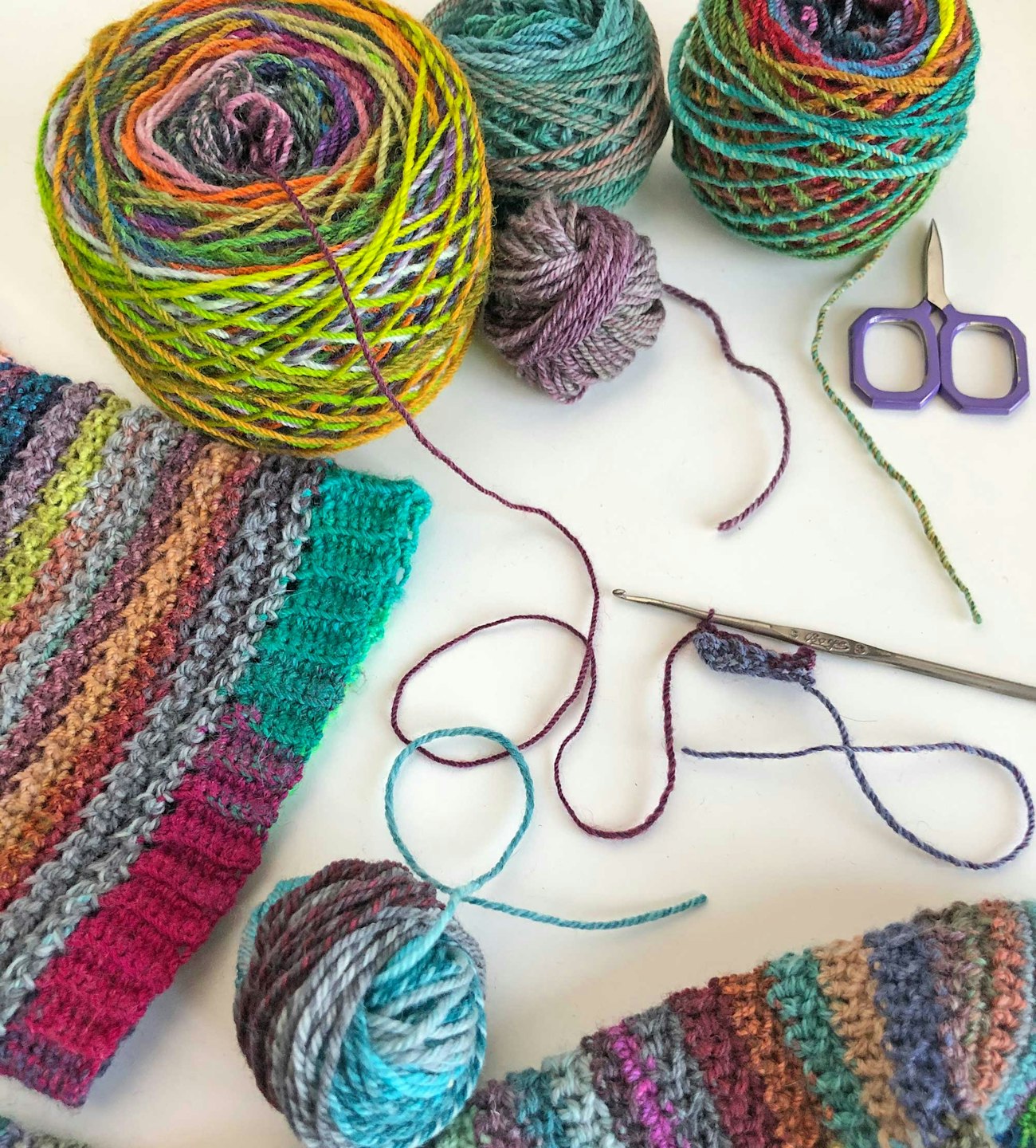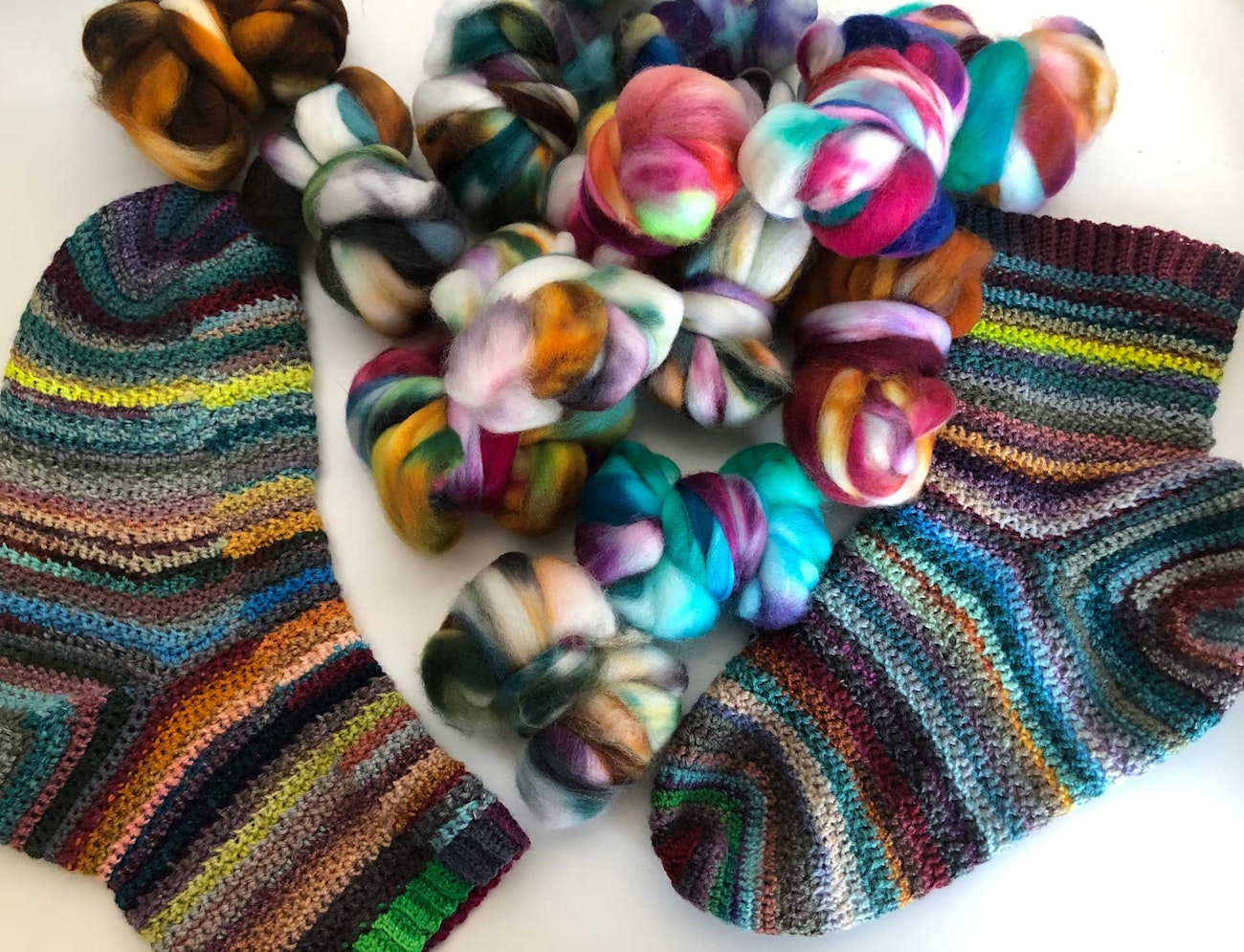Pattern and designer Cosy Toes Cuff Down Socks by Dora Does. I made one modification: I moved the end-of-the-row seam to the front of the sock so that the color-change line could be a design feature.
Fiber/preparation The leftovers from at least 13 different sock yarns went into this pair. All fibers were superwash, mostly Merino or Merino/nylon blend, but one was Targhee. Three of the yarns were spun by other spinners, including one by Micki of A Thing for String and two by Melody of Four Rivers Yarn and Fiber, but the rest of the yarns were my own handspun. All my spins for this project started in roving form. Typically, I separate the roving down the length of the fiber into strips and predraft thoroughly. Fiber dyers included Wound Up Fiber Arts, Sosae Caetano Yarn and Fiber, Woolen Mill St. Yarns, and Fully Spun. Not all the leftovers are from yarns that became other projects; several are from singles remaining on bobbins after plying a three-ply yarn, which I then chain-plied into a mini skein for these socks.
Wheel system/spindle Older yarns were spun and plied on my Lendrum double-treadle wheel with a WooLee Winder. More recent yarns were spun on my Electric Eel Wheel (EEW) Nano 1.1 and then plied on the Lendrum.
Ratio I used a 19:1 ratio when spinning or plying on the Lendrum, and the dial speed was set at maximum when spinning on the EEW Nano.
Drafting method Worsted-style, short-backward draft.
Singles direction S-spun.
Singles wraps per inch About 40 wpi.
Ply wraps per inch 20 wpi.
Plying method Chain-plied, Z-spun yarn with high twist for hard wearing.
Total yardage A lot, but most became other socks!
Yards per pound 1,600 to 1,800 ypp.
Yarn classification/weight Fingering.
Yardage used The finished socks weigh 3.63 ounces, and by my calculations on the various yarns, I used about 443 yards.
Hook I used an antique steel Boye hook marked “3” (2.1 mm) inherited from my grandmother and a modern 3.0 mm hook.
Gauge 29 stitches and 30 rows = 4" in pattern.
Finished size Size small per the pattern to fit my U.S. women’s size 10 feet.
 Renee used the chain-plied leftovers from projects and the singles remaining on bobbins after plying for her scrappy socks.
Renee used the chain-plied leftovers from projects and the singles remaining on bobbins after plying for her scrappy socks.
I learned to knit when I was about ten years old from my great-aunt Marge. During one visit, I asked her how to start, and she showed me the knit stitch and a knitted cast-on. I remember later finding needles and a sparkly blue acrylic yarn amongst my mom’s crafting stuff, and stubbornly, I worked through a square of mistakes until I sorted out the rhythm. My mom shortly thereafter taught me to crochet. In college, I discovered the local yarn store, and while buying a pattern and yarn for my first knitted socks, I asked if they were hiring. A week later, I wore the finished socks to the interview and got the job!
After several years working at the yarn store, I started eyeing spinning as my next fiber hobby. I got a beginning spinning kit and learned from a pamphlet on a drop spindle. By grad school, I had bought my first wheel. After building up a stash of chunky handspun yarns, I realized that I needed to spin for what I was knitting, which was fingering-weight yarn. In 2012, I set the goal of spinning 12 skeins of sock yarn.

Renee used fiber from several indie dyers, including Wound Up Fiber Arts.
In 2021, I was suddenly struck with the impulse to play with tiny hooks and make crochet socks. My first attempt, using commercial yarn, came out too large to fit anyone I know, and I also struggled with the S-plied yarn constantly splitting. I remembered hearing that Z-plied yarns are better for crochet, because the hook wrapping direction adds twist to the yarn instead of subtracting it, which helps to combat splitting. I usually spin singles S and ply my handspun yarns Z, having learned to spin that way on a drop spindle, and I carried on with this method on my wheel. Since I was faced with having to restart the crochet socks anyway, I opted to start over with my handspun.
Just before the crochet urge hit me, I had been browsing for a good scrappy project to use some of my overflowing bag of handspun leftovers. Crochet is fantastic for scrappy projects because the ends can be worked in as you go, so it was an obvious match to use my leftovers for the new pair of crochet socks. For a consistent look, I sorted out the leftovers that were specifically superwash, chain-plied fingering weight. I had about 6 ounces in all.
When making the socks, I really enjoyed changing colors often and picking out the next contrasting color. Some small bits only lasted for one row, while I used the larger leftovers for a maximum of six rows at a time. After struggling with the commercial yarn on my first sock, this handspun pair flew off the hook in a matter of days.
A few of my scraps were from other spinners who spun Z and plied S, and I did notice a distinct difference in the splitting behavior between them and my Z-plied yarns. It was a lot easier to work with the Z-plied yarn. I will definitely be using my own handspun for crocheting in the future!
Have a finished object to share? Tell us about it by sending us an email here.
This article was first published in Spin Off Summer 2021.
Also, remember that if you are an active subscriber to Spin Off magazine, you have unlimited access to previous issues, including Summer 2021. See our help center for the step-by-step process on how to access them.
In addition to making socks, Renee Strouts also delights in tabletop gaming and really bad movies. She can be found spinning, knitting, crocheting, and designing on Instagram as @rmaliase.

